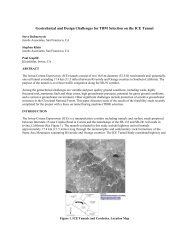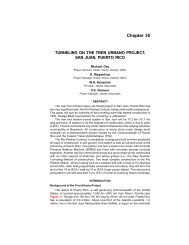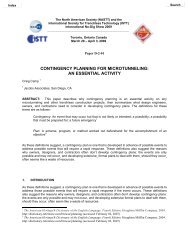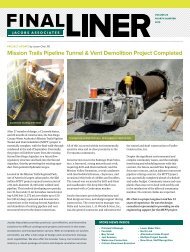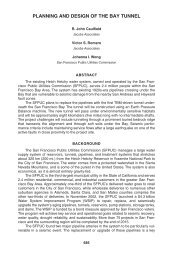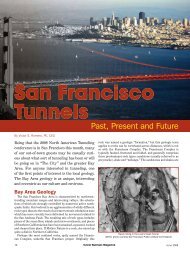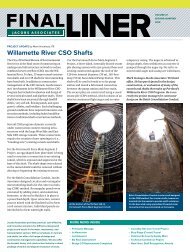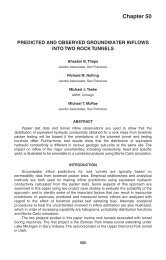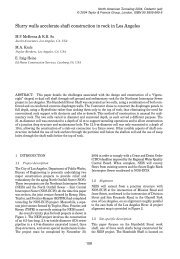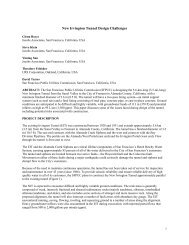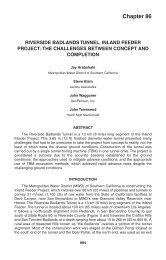Integration of Operations and Underground Construction: Sound ...
Integration of Operations and Underground Construction: Sound ...
Integration of Operations and Underground Construction: Sound ...
Create successful ePaper yourself
Turn your PDF publications into a flip-book with our unique Google optimized e-Paper software.
� The shaft will then be partially backfilled in lifts corresponding to the pile removal sequence above, with<br />
CDF material to allow for the NB tunnel TBM to mine into the shaft.<br />
Figure 5 shows an isometric view <strong>of</strong> the shaft.<br />
Figure 5. View <strong>of</strong> shaft showing existing <strong>and</strong> additional support elements<br />
Access Drift <strong>and</strong> Pile Removal Chamber<br />
In order to avoid surface disruption to Pine Street a 3 × 3 m (10 × 10 ft) access has been designed to be driven from<br />
the shaft above tunnel axis level within the CDF material between the NB <strong>and</strong> SB tunnels. This access drift will take<br />
advantage <strong>of</strong> the existing PSST soldier piles on the east side for support. The drift excavation <strong>and</strong> chamber top<br />
bench will be supported by partial steel sets, with lagging or shotcrete to ensure ground stability, placed in line with<br />
the existing piles. At this stage it will be possible for the upper part <strong>of</strong> the SB tunnel break-out panel to be exposed<br />
<strong>and</strong> removal <strong>of</strong> the concrete will begin. Subsequent benches will be excavated from the top down, exposing the<br />
entire break-out panel for removal <strong>and</strong> the complete length <strong>of</strong> piles <strong>and</strong> laggings to be removed from the tunnel<br />
envelope.<br />
Beginning from the bottom bench, laggings, piles, <strong>and</strong> 0.9 to 1.2 m (3 to 4 ft) <strong>of</strong> existing tieback will be removed<br />
after stabilizing the soldier piles. The lower portions <strong>of</strong> the pile removal chamber are expected to be in the overconsolidated<br />
Qpgm <strong>and</strong> Qpgl materials, which are stiff to very stiff clays. The upper portion <strong>of</strong> the chamber will be<br />
within the zone <strong>of</strong> ground treated soils, which should not become unstable during the short period that they are left<br />
unsupported. Figure 6 illustrates a section through the fully developed access drift <strong>and</strong> pile removal chamber which<br />
is larger than required to accommodate the tunnel envelope (SB tunnel pr<strong>of</strong>ile shown) because <strong>of</strong> the presence <strong>of</strong><br />
tieback anchor points that connect with tiebacks intersecting the tunnel horizon, as well as to allow waterpro<strong>of</strong>ing,<br />
mechanical, electrical, <strong>and</strong> systems connections to the existing PSST structure. To facilitate TBM excavation, the<br />
tiebacks will be disconnected from their associated piles within the pile removal chamber.<br />
6



